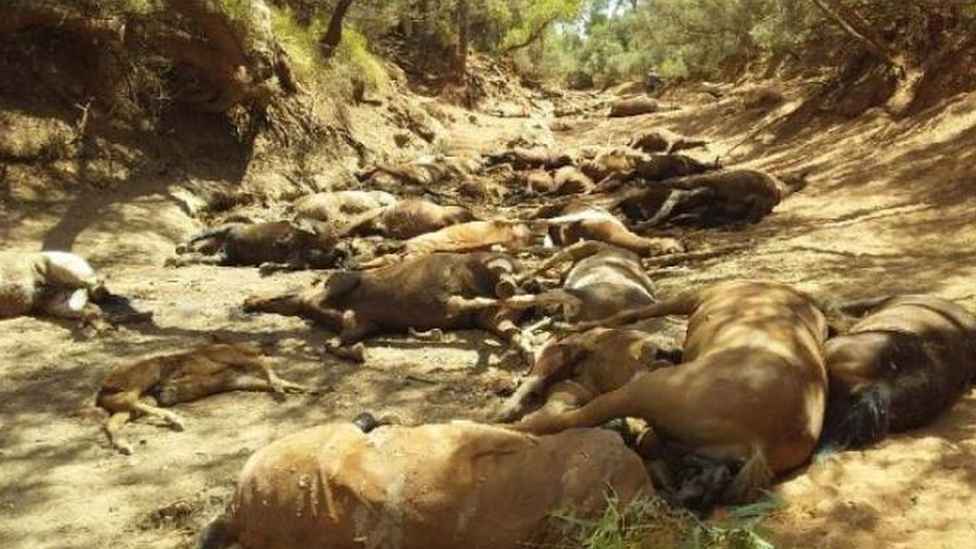INSUBCONTINENT EXCLUSIVE:
Image copyrightRALPH TURNERImage caption
Rangers found the horses in a dried-up waterhole in the Northern Territory
An extreme heatwave in Australia has led to the deaths of more than 90 wild horses in the outback, authorities say.Rangers found
dead and dying animals in a dried-up waterhole near Alice Springs, in the Northern Territory, last week.About 40 of the animals had already
died from dehydration and starvation
Surviving horses were later culled.It comes amid record-breaking heat, with temperatures hitting 49.5C north of Adelaide in South Australia
The mercury rose to 47.7C in the city itself on Thursday, breaking a record set in 1939
How hot is itAustralia has experienced a fortnight of extreme heat that has broken dozens of records across the nation.More than 13 towns in
the state of South Australia have seen heat records eclipsed
Emergency services in more than 13 districts are on alert for fear of possible bushfires
Meanwhile in Alice Springs, near where the horses were found, temperatures have exceeded 42C for almost two weeks - more than 6C above
January's typical average, according to Australia's Bureau of Meteorology.WARNING: Readers may find some images in this article
disturbingHow have animals been affectedRangers came across the horses after their absence was noted by a remote community, said local
authority Central Land Council (CLC).A local resident, Ralph Turner, also visited the site and posted photos online, describing the scene as
"carnage".Image copyrightRALPH TURNERImage caption
The animals were found in the Apwerte Uyerreme waterhole
I'd never seen anything like it - all the bodies," he told the TheIndianSubcontinent
"I couldn't believe something like that had happened."Another local, Rohan Smyth, told the ABC that water was "normally there" and that the
horses "just had nowhere to go".The council said it had organised a cull of the remaining horses because they were found close to
death.Image copyrightRALPH TURNERImage caption
The region has experienced prolonged extreme heat
They
also planned to cull another 120 feral horses, donkeys and camels "dying from thirst" in a neighbouring community, said CLC director David
Ross."With climate change well and truly upon us, we expect these emergencies to occur with increasing frequency and nobody is truly
prepared and resourced to respond to them," Mr Ross wrote in a press release
Several other wildlife species have also suffered, with reports of mass deaths of native bats in New South Wales
Up to a million fish have also been found dead along river banks in the drought-affected state.Image:Locals in New South Wales are angry
about the mass deaths of fishThe government has launched a review into the fish deaths
How have people been copingSouth Australia health authorities said 44 people had come in for treatment in the space of 24 hours due to the
Officials nationwide have issued health warnings urging people to stay indoors and minimise physical activity, with heightened concerns for
the elderly, the chronically ill and children.Earlier this month, officials confirmed that 2018 and 2017 had been Australia's third and
fourth hottest years on record respectively.Image copyrightGetty ImagesImage caption
People have flocked to the beach to
help cope with the heat
The bureau's State of the Climate 2018 report said climate change had led to an increase in extreme
heat events.How is climate change affecting AustraliaEven if global temperatures are contained to the Paris accord limit of a 2C rise above
pre-industrial levels, scientists believe Australia is facing a dangerous new normal
Parts of eastern Australia suffered their worst drought in recent history last year, while thousands of Australians fled their homes when
bushfires swept through Queensland in November.The country has committed to reducing its emissions by 26-28% on 2005 levels by 2030, under
the Paris climate agreement.But in November, school students nationwide left class in protest at what they said was a response the
government's inadequate action on climate change
According to the UN's 2018 emissions gap report, Australia's climate policy saw no improvement in 2017, and emission levels for 2030 are
projected to be above target.

